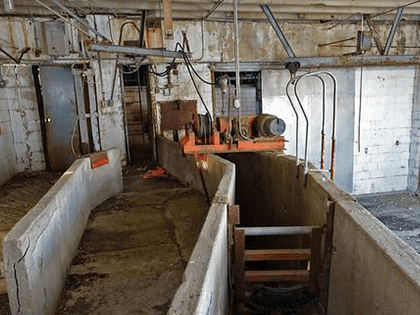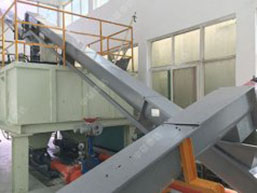Slaughter sludge is the product formed by sewage separation from stomach contents, feces, hem agglutination products and fur of livestock after slaughter. It is with high moisture content and easily perishable. There is foul smell, a large number of pathogenic microorganisms and parasite eggs produced along with slaughter sludge. Without proper disposal, it will not only pollute water body, but also cause air pollution and the spread of germs. The treatment of sludge in the slaughterhouse is mainly: Biogas after simple fermentation is discharged into water body. A small part of slaughter sludge will be naturally decomposed as fertilizer for crops, but without suitable treatment, it can easily cause environmental damage. At present, treatment methods of sludge mainly include sanitary landfill, incineration, anaerobic fermentation and aerobic composting. Among them, composting methods refers to process that transfer sludge mixing filling materials to resources and reach harmless aim under suitable condition, moisture, temperature PH value and ventilation. Maturity is an important basis for composting process control and composting product quality evaluation.
Aimed at this situation, Zonelion Taeda has proposed various thermal drying technologies to meet demands in different regions for drying manure sludge. If you need deep resource-based technical solutions, you can also contact us for entire deep processing technology and equipment manufacturing support services.
In terms of slaughter sludge reduction by drying, Zonelion Taeda® recommends following drying technologies and equipment that have been optimized for many years and are highly praised: low temperature belt drying system, waste heat low temperature drum drying system, steam rotary drum drying system, rotary drum sludge drying system and air swept rotary wing drying system. You can click on the "Recommended Process" below for details of above dryers and corresponding technologies. You can also call us directly for quotation and technical support.
1、High thermal efficiency and low drying cost
New internal structure strengthens material cleaning and heat conduction function and eliminate sludge sticking phenomenon. It can well adapt to material; moisture and stickiness. Heat exchanging area is increased and drying efficiency is improved. Operating parameters can be changed according to different materials. Entire drying system adopts variable frequency speed control to make material heat exchange in the dryer more fully. Coal consumption (other fuels are optional) and power consumption are decreased by 20-25% compared with ordinary dryers. From feeding to discharging, whole process runs in a full closed environment which can prevent entrance of cold air to system. Heat source utilization rate is improved and final product quality can be guaranteed.
2、Reliable running and good stability
New type of feeding/discharging device avoids feeding block, discontinuity, unevenness and material returning. The drying system greatly reduces abrasion and power consumption. It greatly reduces abrasion between catch wheel and riding wheel. Operation is more stable and reliable.
3、Wide fuel application and environmental friendly
Fuels can be coal, oil, natural gas, and liquefied gas. It can be determined according to material requirements and local natural advantages to improve production efficiency and economic benefits. Our company’s new produc, coal gasifier and biomass combustion furnaces are used as heat carriers. Whole process is featured in energy saving, environmental protection, safety and sanitation, no pollution to raw material and high thermal efficiency. Its thermal efficiency is 30% higher than combustion furnace. One operator is enough. No need to charge coal circularly. It can be stopped anytime according to demands.
4、High automation level and fulfill real time production supervision
Whole system can be equipped with PLC automatic control. The system includes advanced detection equipment like temperature detection, pressure detection, temperature adjustment (adjustable at any time according to material needs), automatic fault alarm, automatic protection shutdown and other functions. It can also be equipped with industrial television monitoring system for inspecting and controlling of production status and situation so that to make drying equipment better meet demands.
-
 Low-temp Belt Drying System
Low-temp Belt Drying System
-
 Exhaust Heat Drum Drying
Exhaust Heat Drum Drying
-
 Steam Rotary Drying System
Steam Rotary Drying System
-
 Rotary Drum Drying System
Rotary Drum Drying System
-
 Air Swept Drying System
Air Swept Drying System
| Model | Working principle | Working temperature | Heat source | Occupation area | Brand | Capacity |
| ℃ | t/h |
| MED | Hot air rotary drum dryer | 200-750 | electricity, gas, oil, coal and biomass pellets | Middle | Taeda | 0.5-50 |
| WWD | Circulation hot air mesh belt dryer | 60-300 | electricity, gas, heat conduction oil, hot water,exhaust gas, heat | Large | Zonelion | 0.05-5 |
| OSC | Airflow fluid bed dryer | 120-750 | electricity, gas, oil, coal and biomass pellets | Very small | 中联泰达 | 0.1-10 |
| GD | Steam tube rotar drum dryer | 100-170 | steam, heat conduction oil, hot water | Relatively large | Taeda | 0.1-8 |
| WRC | Low temperature large air volume rotary drum dryer | 45-750 | flue gas, exhaust gas, steam heat exchanging | Relatively large | Zonelion | 0.1-20
|
 中文
中文 English
English Home
Home













